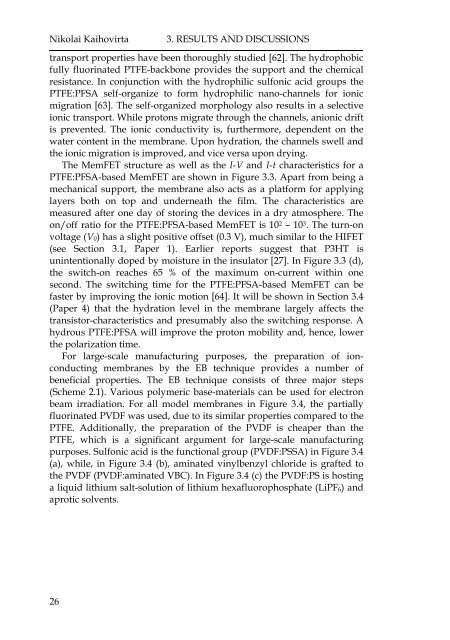ION MODULATED ORGANIC TRANSISTORS - Doria
ION MODULATED ORGANIC TRANSISTORS - Doria
ION MODULATED ORGANIC TRANSISTORS - Doria
- No tags were found...
Create successful ePaper yourself
Turn your PDF publications into a flip-book with our unique Google optimized e-Paper software.
Nikolai Kaihovirta3. RESULTS AND DISCUSS<strong>ION</strong>Stransport properties have been thoroughly studied [62]. The hydrophobicfully fluorinated PTFE-backbone provides the support and the chemicalresistance. In conjunction with the hydrophilic sulfonic acid groups thePTFE:PFSA self-organize to form hydrophilic nano-channels for ionicmigration [63]. The self-organized morphology also results in a selectiveionic transport. While protons migrate through the channels, anionic driftis prevented. The ionic conductivity is, furthermore, dependent on thewater content in the membrane. Upon hydration, the channels swell andthe ionic migration is improved, and vice versa upon drying.The MemFET structure as well as the I-V and I-t characteristics for aPTFE:PFSA-based MemFET are shown in Figure 3.3. Apart from being amechanical support, the membrane also acts as a platform for applyinglayers both on top and underneath the film. The characteristics aremeasured after one day of storing the devices in a dry atmosphere. Theon/off ratio for the PTFE:PFSA-based MemFET is 10 2 – 10 3 . The turn-onvoltage (V 0) has a slight positive offset (0.3 V), much similar to the HIFET(see Section 3.1, Paper 1). Earlier reports suggest that P3HT isunintentionally doped by moisture in the insulator [27]. In Figure 3.3 (d),the switch-on reaches 65 % of the maximum on-current within onesecond. The switching time for the PTFE:PFSA-based MemFET can befaster by improving the ionic motion [64]. It will be shown in Section 3.4(Paper 4) that the hydration level in the membrane largely affects thetransistor-characteristics and presumably also the switching response. Ahydrous PTFE:PFSA will improve the proton mobility and, hence, lowerthe polarization time.For large-scale manufacturing purposes, the preparation of ionconductingmembranes by the EB technique provides a number ofbeneficial properties. The EB technique consists of three major steps(Scheme 2.1). Various polymeric base-materials can be used for electronbeam irradiation. For all model membranes in Figure 3.4, the partiallyfluorinated PVDF was used, due to its similar properties compared to thePTFE. Additionally, the preparation of the PVDF is cheaper than thePTFE, which is a significant argument for large-scale manufacturingpurposes. Sulfonic acid is the functional group (PVDF:PSSA) in Figure 3.4(a), while, in Figure 3.4 (b), aminated vinylbenzyl chloride is grafted tothe PVDF (PVDF:aminated VBC). In Figure 3.4 (c) the PVDF:PS is hostinga liquid lithium salt-solution of lithium hexafluorophosphate (LiPF 6) andaprotic solvents.26
















